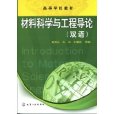《材料科學與工程導論(雙語)》是2011年化學工業出版社出版的圖書,作者是陳克正。
基本介紹
- 書名:材料科學與工程導論(雙語)
- 作者:陳克正
- 出版社:化學工業出版社
- 出版時間:2011年8月1日
- 定價:29 元
- 開本:16 開
- ISBN:9787122117588
內容簡介,圖書目錄,
內容簡介
本書主要介紹了的緒論,固體材料的結構,常用工程材料(高分子材料、金屬材料、陶瓷材料和複合材料)的結構、力學性能、成分、加工工藝以及套用前景,常用工程材料的化學性能(耐腐蝕性能)和物理性能(電、磁、熱和光學性能)以及新型材料(生物材料、納米材料和智慧型材料)的介紹等內容。《材料科學與工程導論(雙語)》可供大專院校材料科學與工程及相關專業師生使用,也可供從事材料科學與工程研究、開發及管理的人員參考。
圖書目錄
Chapter 1 Introduction1
Learning Objectives1
1.1 Historical Perspective1
1.2 What is Materials Science and Engineering?2
1.3 Why Study Materials Science and Engineering?5
1.4 Classification of Materials5
1.5 Advanced Materials9
1.6 Modern Materials’ Needs10
References11
Chapter 2 The Structure of Crystalline Solids13
Learning Objectives13
2.1 Atomic Structure and Interatomic Bonding13
2.1.1 Fundamental Concepts14
2.1.2 Bonding Forces and Energies14
2.1.3 Atomic Bonding in Solids16
2.2 Crystal Structures22
2.2.1 Fundamental Concepts22
2.2.2 Metallic Crystal Structures and Crystal Systems23
2.2.3 Crystallographic Points,Directions,and Planes30
2.2.4 Crystalline and Noncrystalline Materials37
2.3 Imperfections in Solids40
2.3.1 Point Defects in Metals40
2.3.2 Dislocations—Linear Defects43
2.3.3 Interfacial Defects44
2.3.4 Bulk or Volume Defects46
References48
Chapter 3 Polymer Materials49
Learning Objectives49
3.1 Polymer Structures49
3.1.1 Introduction49
3.1.2 Fundamental Concepts49
3.1.3 Polymer Molecules50
3.1.4 Designation of Polymers50
3.1.5 Commonly Used Polymers51
3.1.6 The Chemistry of Polymer Molecules58
3.2 Crystallization,Melting and Glass Transition Phenomena in Polymers65
3.3 Mechanical Properties of Polymers66
3.3.1 Stress-Strain Behavior67
3.3.2 Macroscopic Deformation68
3.3.3 Viscoelastic Deformation70
3.4 Polymer Types71
3.4.1 Plastics71
3.4.2 Elastomers72
3.4.3 Fibers73
3.4.4 Miscellaneous Applications Coatings73
3.5 Processing of Polymers74
3.5.1 Polymerization75
3.5.2 Polymer Additives76
3.5.3 Forming Techniques for Plastics78
3.5.4 Fabrication of Elastomers80
3.5.5 Fabrication of Fibers and Films81
References84
Chapter 4 Metallic Materials85
Learning Objectives85
4.1 Mechanical Properties of Metals85
4.1.1 Introduction85
4.1.2 Tensile Test86
4.1.3 Hardness Testing90
4.2 Dislocations and Strengthening91
4.2.1 The Role of Dislocations91
4.2.2 Work Hardening93
4.2.3 Grain Size Strengthening93
4.2.4 Alloy Hardening94
4.3 Failure96
4.3.1 Introduction96
4.3.2 Fundamentals of Fracture97
4.3.3 Ductile Fracture97
4.3.4 Brittle Fracture98
4.3.5 Fracture Mechanics in Design99
4.3.6 Fracture Toughness100
4.3.7 Fatigue101
4.3.8 Creep101
4.4 Phase Diagrams and Phase Transformations in Metals102
4.4.1 Introduction102
4.4.2 Phase Diagrams103
4.4.3 Phase Transformations107
4.5 Applications and Processing of Metal Alloys108
4.5.1 Introduction108
4.5.2 Types of Metal Alloys109
4.5.3 Fabrication of Metals113
4.5.4 Thermal Processing of Metals115
References120
Chapter 5 Ceramic Materials123
Learning Objectives123
5.1 Structures and Properties of Ceramics123
5.1.1 Introduction123
5.1.2 Ceramic Structures123
5.1.3 Mechanical Properties of Ceramics127
5.2 Application and Processing of Ceramics129
5.2.1 Types and Applications of Ceramics129
5.2.2 Fabrication and Processing of Ceramics131
References136
Chapter 6 Composite Materials137
Learning Objectives137
6.1 Introduction137
6.2 Particle-Reinforced Composites138
6.2.1 Large-Particle Composites139
6.2.2 Dispersion-Strengthened Composites140
6.3 Fiber-Reinforced Composites140
6.3.1 The Fiber Phase140
6.3.2 The Matrix Phase141
6.4 Polymer-Matrix Composites142
6.4.1 Glass Fiber-Reinforced Polymer(GFRP)Composites142
6.4.2 Carbon Fiber-Reinforced Polymer(CFRP)Composites143
6.4.3 Aramid Fiber-Reinforced Polymer Composites143
6.5 Metal-Matrix Composites145
6.6 Ceramic-Matrix Composites146
References149
Chapter 7 Corrosion and Degradation of Materials150
Learning Objectives150
7.1 Introduction150
7.2 Corrosion of Metals150
7.2.1 Electrochemical Considerations151
7.2.2 Corrosion Rates153
7.2.3 Passivity153
7.2.4 Environmental Effects153
7.2.5 Forms of Corrosion154
7.2.6 Corrosion Environments158
7.2.7 Corrosion Prevention159
7.3 Corrosion of Ceramic Materials159
7.4 Degradation of Polymers160
7.4.1 Swelling and Dissolution160
7.4.2 Bond Rupture160
7.4.3 Weathering161
References163
Chapter 8 Electrical/Thermal/Magnetic/Optical Properties of Materials164
Learning Objectives164
8.1 Introduction165
8.2 Electrical Properties of Materials165
8.2.1 Metals and Alloys166
8.2.2 Semiconductors167
8.2.3 Ionic Ceramics and Polymers170
8.3 Thermal Properties of Materials170
8.3.1 Heat Capacity170
8.3.2 Thermal Expansion171
8.3.3 Thermal Conductivity172
8.3.4 Thermal Stresses172
8.4 Magnetic Properties of Materials174
8.4.1 Diamagnetism,Paramagnetism and Ferromagnetism174
8.4.2 Antiferromagnetism and Ferrimagnetism177
8.4.3 The Influence of Temperature on Magnetic Behavior179
8.4.4 Domains,Hysteresis and Magnetic Anisotropy179
8.4.5 Superconductivity181
8.5 Optical Properties of Materials186
8.5.1 Interaction of Light with Matter186
8.5.2 Atomic and Electronic Interactions187
8.5.3 Refraction,Reflection,Absorption and Transmission190
8.5.4 Opacity and Translucency in Insulators192
8.5.5 Applications of Optical Phenomena192
References197
Chapter 9 Biomaterials/Nanomaterials/Smart Materials198
Learning Objectives198
9.1 Biomaterials198
9.1.1 Definition of Biomaterials199
9.1.2 Performance of Biomaterials202
9.1.3 Brief Historical Background203
9.2 Nanotechnology and Nanomaterials205
9.2.1 Introduction205
9.2.2 Examples of Current Achievements and Paradigm Shifts209
9.3 Smart Materials214
9.3.1 Introduction214
9.3.2 Shape Memory Alloys215
9.3.3 Applications of Smart Materials219
Reference220

